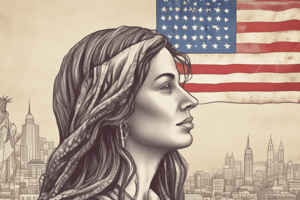Podcast
Questions and Answers
The Seneca Falls Convention was held in ______, New York, in 1848.
The Seneca Falls Convention was held in ______, New York, in 1848.
Seneca Falls
The convention's core document was the Declaration of ______, modeled after the Declaration of Independence.
The convention's core document was the Declaration of ______, modeled after the Declaration of Independence.
Sentiments
Organized primarily by ______ Mott and Elizabeth Cady Stanton, the convention aimed to address women's inequalities.
Organized primarily by ______ Mott and Elizabeth Cady Stanton, the convention aimed to address women's inequalities.
Lucretia
Women were denied the right to ______, considered legal minors, and unable to own property.
Women were denied the right to ______, considered legal minors, and unable to own property.
Martha Coffin Wright was a significant ______ in the convention, contributing to discussions on women's rights.
Martha Coffin Wright was a significant ______ in the convention, contributing to discussions on women's rights.
The convention fostered a sense of ______ and collective action amongst women.
The convention fostered a sense of ______ and collective action amongst women.
Elizabeth Cady Stanton was a key organizer and ______ of the Declaration of Sentiments.
Elizabeth Cady Stanton was a key organizer and ______ of the Declaration of Sentiments.
The Seneca Falls Convention marked a turning point in the American women's rights ______.
The Seneca Falls Convention marked a turning point in the American women's rights ______.
Women faced limited access to education and employment, often confined to ______ roles.
Women faced limited access to education and employment, often confined to ______ roles.
The Declaration of Sentiments became a cornerstone document for the women's rights ______.
The Declaration of Sentiments became a cornerstone document for the women's rights ______.
Flashcards
Seneca Falls Convention
Seneca Falls Convention
A landmark event in the US women's rights movement, held in 1848, that aimed to address social, legal, and political inequalities faced by women. It was organized by prominent figures like Lucretia Mott and Elizabeth Cady Stanton.
Declaration of Sentiments
Declaration of Sentiments
A document written at the Seneca Falls Convention, modeled after the Declaration of Independence, outlining grievances and demands for women's rights.
Women's Suffrage and Legal Rights
Women's Suffrage and Legal Rights
A key issue addressed at Seneca Falls, highlighting the fact that women were not allowed to vote, own property, or have the same legal rights as men.
Lucretia Mott
Lucretia Mott
Signup and view all the flashcards
Elizabeth Cady Stanton
Elizabeth Cady Stanton
Signup and view all the flashcards
Outcomes and Impact of the Seneca Falls Convention
Outcomes and Impact of the Seneca Falls Convention
Signup and view all the flashcards
Women's Access to Education and Employment
Women's Access to Education and Employment
Signup and view all the flashcards
Women's Legal Rights and Inequality
Women's Legal Rights and Inequality
Signup and view all the flashcards
Women in Public Life and Political Participation
Women in Public Life and Political Participation
Signup and view all the flashcards
Study Notes
Seneca Falls Convention (1848)
- The Seneca Falls Convention, held in Seneca Falls, New York, in 1848, was a pivotal event in the U.S. women's rights movement.
- Organized primarily by Lucretia Mott and Elizabeth Cady Stanton, the convention aimed to address social, legal, and political inequalities faced by women.
- The convention's core document was the Declaration of Sentiments, modeled after the Declaration of Independence.
- The Declaration of Sentiments outlined grievances and demands for women's rights, emphasizing voting rights, equal educational and employment opportunities, and property rights.
Key Grievances Addressed in the Declaration
- Women were denied voting rights, considered legal minors, and unable to own property.
- Women had limited access to education and employment, often confined to domestic roles.
- Women lacked equal legal rights to men, facing discriminatory laws in divorce, custody, and inheritance.
- Women were excluded from public life and denied participation in political processes.
Key Figures and their Roles
- Lucretia Mott: A prominent abolitionist and women's rights advocate, crucial in organizing and shaping the convention's agenda.
- Elizabeth Cady Stanton: A key organizer and writer of the Declaration of Sentiments, articulating the demands for women's rights.
- Martha Coffin Wright: A significant participant, contributing to discussions about women's rights.
- Mary M'Clintock: A participant and voice for women's rights.
Outcomes and Impact
- The Seneca Falls Convention was a turning point in the American women's rights movement, establishing the foundation for future activism and legislation.
- The Declaration of Sentiments became a pivotal document, articulating movement demands and garnering support for women's rights.
- The convention fostered unity and collective action among women, inspiring organization and advocacy.
- Though initially met with criticism and skepticism, its legacy inspired significant activity, bringing incremental changes in women's legal rights, increased political engagement, and broader discussions about gender equality.
Limitations and Challenges Facing the Movement
- Despite initial successes, full equality remained a formidable challenge, needing decades to achieve.
- The convention was initially limited in geographical reach, largely concentrated in the northeastern United States and predominantly among white women.
- The movement faced opposition from those who believed women's roles should be confined to the domestic sphere.
- Limited support from men and some members of the broader community hampered the immediate realization of goals, leading to short-lived or challenged gains in early stages.
Studying That Suits You
Use AI to generate personalized quizzes and flashcards to suit your learning preferences.




